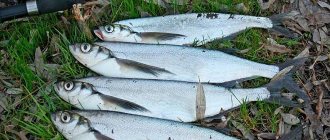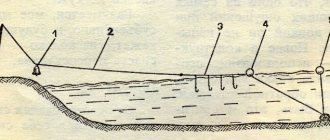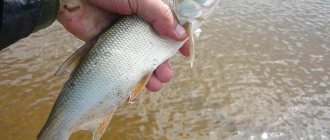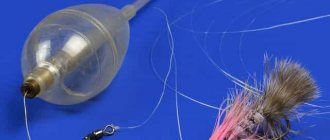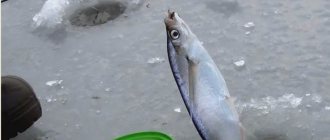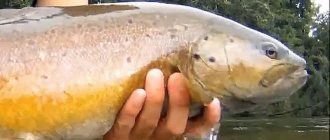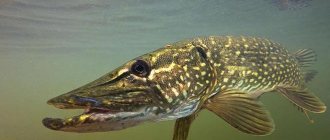A bombard is a kind of float that has a transparent body, through the inside of which a fishing line passes. Differences in the weight of the devices make it possible to experiment when assembling equipment.
The bombard is used when throwing very light baits (for example, a miniwister) over a long distance. This equipment will be most effective for catching saberfish.
The sabrefish moves in schools; the feeding site is not always located close to the shore. Most often these are long distances; it is worth taking binoculars with you for hunting. Very often this type of fish ignores spinning and spinner fishing. It is in such cases that it is worth using bombard equipment.
Bombard equipment for sabrefish
A bombard is a transparent float through which monofilament is passed. This type of fishing tackle is often used for casting baits with a small weight. If we take into account the buoyancy characteristics of the bombard, it can be neutral or negative.
It is best to use a worm or maggot as bait. Indeed, in this case, natural origin is required. Directly under the bombard itself there is a stopper for fixing the equipment in the desired position. It is called a stopper.
After which it is necessary to fix the leash and bait. In order for catching sabrefish with a bombard to be more than effective, you need to follow a few recommendations in the process of landing fish. So, you should slowly reel in the gear immediately after casting it into the water.
Bombard gear device
Here is the simplest gear organization diagram.
It includes such mandatory components as:
- Types of float (bombard)
The main line of the fishing rod. - Bombarda (sbirulino) is a heavy floating float that allows you to make long casts.
- Stopper (bead).
- Swivel to prevent line twisting.
- A leash is a small piece of fishing line with a thin diameter so as not to scare wary fish.
- Bait, which usually consists of flies and artificial baits, baits of plant and animal origin. Sometimes even foam fish for catching predatory fish.
Installation. The reel is used without inertia, it is attached to the fishing rod. A fishing line, preferably made of fluorocarbon, is passed through the rings and through the bombard, it is not visible in the water. The swivel is protected from impacts by a silicone stopper.
There are three types of sbirulino float. This:
- floating;
- sinking quickly;
- slowly sinking.
Floating sbirulino slowly sinks in the water. You can create slow or multi-stage wiring.
A quickly sinking sbirulino sinks the bait deeply and is not brought to the surface of the water.
Slowly sinking, suitable for active fish, allows you to make movements throughout the entire depth of the reservoir.
Bombarda for sabrefish also required special fishing rods. They soon appeared on the market. These are longer rods than for regular spinning fishing, up to 4.5 meters long and have a slow action, that is, soft. As an example, we can cite a rod of the “Aji” class with test indicators of up to 12 grams, having a hollow tip of the “tubular tip” type. For twitch fishing, where twitch jerks are used, fast action rods can also be used.
The rig with a bombard is a scheme consisting of a main line, a bombard, a bead damper and a leash on which a mini jig is attached, and on the hook there is an edible rubber bait. The damper bead serves to soften the inevitable jerks when casting. The leash is usually made about 80-100 cm long and uses fluorocarbon fishing line with a diameter of 0.18-0.2 mm.
You can also use thicker leashes, especially where catching large sabrefish is not uncommon. Fluorocarbon fishing line has an important property - it is almost invisible in the water due to the angles of refraction of light in the water when it hits this special fishing line. But at the same time, fluorocarbon fishing line is inferior in strength to conventional monofilament fishing line.
Catching sabrefish with a bombard is most successful using the smallest baits made of edible rubber, which are also attached to the lightest jig heads weighing no more than 0.2-0.5 grams. The bombard helps deliver such almost weightless baits to the longest distances of spinning casts.
Most often, for fishing for saberfish, so-called sticks are used - weakly playing baits, usually made of edible rubber, and also very stretchy rubber, which is also called stretch. This increased stretchability of the sticks prevents greedy fish from tearing off the pseudo-tails of the baits, which often happens when fishing with standard silicone twisters and vibrating tails.
Installation of a bombard on a cover
To install this type of gear, you need to first prepare several bombards of excellent weight. In this case, you should be guided by the purely desired casting distance. Moreover, the bait must reach the desired place in the reservoir and slowly sink into the water column.
The bombard is mounted on the main monofilament. Then the bead is installed as a locking element. Following it, it is recommended to attach a carabiner, and attach a leash 10 cm long and 0.2–0.22 mm in diameter to it. The hook is best used at number 4. A worm or maggot should be strung on it.
The equipment is cast directly into the habitat of a school of sabrefish. After which, experienced fishermen recommend carefully and slowly reeling in the bait, with small pauses and jerks. Most often, in the initial stage of wiring, the saberfish begins its attack. Therefore, you won’t have to wait long if the fishing spot was chosen correctly.
Flies for catching sabrefish
After installing the bombard, it is recommended to start choosing flies. In this case, the diet of sabrefish will be dominant during a certain period of the year.
It’s not for nothing that the saberfish is often called a small copy of the asp. They even have a somewhat similar diet: whitebait and other small insects that live on the surface of the reservoir. Therefore, the flies should resemble a mosquito or a fry.
It's no secret that saberfish live in flocks. That is why during the installation of flies it is recommended to use them in quantities of several pieces. This greatly improves the efficiency and effectiveness of the tooling.
There is a little trick that will help you when fishing. Chekhon prefers to attack sinking bait models. Therefore, you can use sinking flies or a bombard, which slowly sinks into the water column.
The best baits for catching sabrefish using a bombard
The basic baits for catching sabrefish using a bombard are:
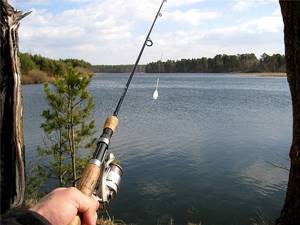
- small wobblers;
- foam balls;
- small fish made of silicone;
- spinner spoons No. 00, No. 0, No. 1 sizes;
- twisters of small dimensions.
When the situation arises that sabrefish no longer catch these baits of artificial origin, it is necessary to replace them.
A worthy and, most importantly, effective replacement would be bait of animal origin, for example, maggots, dung worms or whitebait.
Most often, with such bait the fish bite only intensifies. And in order to ensure long-distance casting of such a light bait, the bombard method is suitable. It is ideal for a specific case.
Standard bombard assembly
This assembly is very popular among fishing enthusiasts. Fishing with a bombard with such equipment is successful, and assembly is not difficult. The float must first be attached to the main line, and the float should not move freely along the line. And this can be done using the upper and lower stopper. If the float is not fixed, then when casting it will cling to the swivel.
After this, you can attach the swivel itself. Now you should attach the leash; it should be made of a thinner fishing line than the main fishing line. Its length can be 1.5-3 meters. At first, you should not use several hooks, it is better to take one. When the fisherman gains some skills in using such equipment, it will be possible to use several hooks at the same time. After all, long casts are quite difficult to perform.
How to fish with a bombard?
When catching sabrefish with a bombard, it is imperative to ensure high flight characteristics of the bombard. Indeed, in this case it is necessary to deliver the bait directly to the fish’s habitat.
If you use spinners or wobblers during fishing, which most often occurs at the surface of the reservoir, then experts advise waiting for the sheresper to strike.
In this case, the bite of the bombard rig is determined both by the behavior of the float and by the tip of the spinning rod. And if you use particularly sharp hooks, the saber fish will be able to hook itself. This will only increase the efficiency and effectiveness of your fishing. After all, the fish will definitely not get off the hook.
So, in the process of organizing the wiring for catching sabrefish on a bombard, it is necessary to make several smooth alternating pull-ups. This is done to simulate a drowning insect that is unable to take off from the surface of the water.
Catching sabrefish with a bombard on the Oka
Practice shows that most often schools of fish are located as follows: a school of sabrefish stands next to the coastal zone, and asps are located a little further away. One even gets the impression that they divided the area into sectors. And they don’t interfere, but help each other hunt.
Although there are cases when fattening shoals of sabrefish do not show themselves in any way. They hunt quietly in the lower layers of the reservoir and do not bother anyone. That is why it is important to know the topography of the bottom of the reservoir where predators prefer to live.
A striking example of this will be the Oka bend, which is next to Kasimov. Transverse underwater terraces are located here. They are presented in the form of specific shafts 40–50 cm high and 10–15 m long.
It is in these places that whole flocks of saberfish live. They are not very large, 10–15 individuals each, but it’s already nice. Whereas further, above the ridges of other terraces, you can go out to shoals of asp. The main thing is to calculate the location accurately. And there, fishing with a bombard will definitely bring success.
Catching sabrefish with a bombard on the Kama
Many fishermen note that on the Kama they had to catch both large and small schools of sabrefish. It is very rare to find mixed versions of them. For fishing, it is best to choose places in the upper layers of water, above great depths.
Good bite along the forest rafts moored to the coast.
Apparently, the fish here feed on larvae, which are washed out from under the bark of trees by strong currents.
Although the rafts themselves have long been a thing of the past.
It is effective to catch sabrefish using a bombard on the Kama River, baiting a hook with a fish or grasshopper, from rapids in calm water.
Moreover, there are many positive comments about the sunken barge.
It is here that whole sandy outcrops are formed downstream, and slightly higher, in the direction of the fairway, places with great depth begin.
The watering area is always full of vast plantations of vegetation and algae. Apparently, the whitebait living here attracted the sabrefish to these places.
For fishing with a bombard, it is recommended to release the bait over a long distance. After all, fish fattening near the surface of a reservoir are not so naive. She will never allow a fisherman to get close to her.
Therefore, it is best to catch sabrefish from the coastal zone or from a boat. It is recommended to make casts perpendicular to the board. This is the case when it is difficult to anchor to lower the bait astern.
Since the water in shallow water is very warm during the daytime, the inhabitants of the aquatic world do not feel comfortable in these places. The fry moves towards the depths, and the invertebrates hide in the sand or behind rock piles.
Best of all, sabrefish bite on the surface of a reservoir at dawn. Because it is at this time, after the heat of the day, that various insects are most active, involuntarily falling into the water column.
Seasons and fishing
Methods of catching fish, namely sabrefish, depend on the type of bombard. Considering that a bombard is, to put it simply, a heavier float, the size and weight of this float is selected for catching sabrefish at depths that correspond to the season. And for this there are different types of bombard floats, which can be either floating, slowly sinking, or quickly sinking. It is clear that for a fly from a fly fishing kit a floating bombard is more suitable, but for a jig bait you need a fast-sinking bombard.
Bombards for sabrefish have different markings that meet the criteria specified above, and the markings indicate the weight of the float bombard and the buoyancy force. Usually the first number indicates the weight of the bombard - gr. Then comes the buoyant force or lifting force - G or maybe - GALL.
Sometimes, for fishing in the middle and bottom water levels, instead of sinking and quickly sinking ones, bombards with a deflection angle are used. These bombards have a slightly bent wire bow on which the leash is attached. This angle allows the bombard to deepen to the desired level in the water column.
We suggest you read: Fishing on a balda in winter, how to make a balda
Bombards themselves are quite heavy floats. They can weigh up to 15 g. But most often miniature and lightweight bombards with good aerodynamics are used. This helps when retrieving the bait and, of course, when casting.
Description of Chekhon fish
Methods of catching sabrefish
Chekhon for spinning
How to catch saberfish with a fishing rod
Catching sabrefish with an elastic band
You can learn about other fishing methods and fish on the website: All about fishing.
Good fishing online stores will allow you to purchase any fishing goods at competitive prices!
Fish behave differently at different times of the year, have certain habitats and preferences for bait. Changes in temperature change the behavior of fish and their habits. To determine the strategy, you need to know the characteristics of fishing in each season.
In spring, fish rush to shallows, river mouths, and bays. After the water is cleared, the bite is very successful. In stagnant bodies of water (ponds, lakes), the bite begins later. Hungry fish take different types of bait, cool weather contributes to a good bite.
In summer, in reservoirs, vegetation quickly multiplies in warmed water, and fish go deeper into cooler layers. To feed, fish accumulate on the rifts and in the shallows. Fishing should begin early in the morning or at sunset. In hot weather, the fish bite poorly. It is good to flavor the bait with fragrant oils - anise, valerian, etc. Fish bite better in muddy water.
In the fall, the fish gather in schools and go into deep waters, bite during daylight hours, actively feed, and prepare for the winter. In bad weather, the bite stops.
Fishing is carried out in pools, pits, and quarries.
Fishermen successfully catch predatory and peaceful fish using a bombard:
- pike;
- chub;
- perch;
- ide;
- saberfish;
- trout,
- salmon
On top of the fly you can catch pike, sabrefish, bleak, chub, asp, grayling, rudd, trout on paid ponds. You can buy a fly or make it yourself.
Images of fish that are not averse to biting on the bombarda.
| Chub | Rudd | Asp | Salmon | Grayling | Chekhon | Pike |
On warm days the fish jump out of the water, then it is recommended to use artificial caddis bait. Small flies are best used on smooth water.
A fast-sinking bombard allows you to lower the bait to the bottom. This leads to a successful bite; fishing along the bottom attracts:
- chub;
- roach;
- perch;
- pike perch;
- bream;
- carp
With proper equipment, the bait will not be carried to the surface of the water. It can be carried out against the current along the bottom or above its surface.
Adviсe
- During the spawning and post-spawning periods, sabrefish always adhere to the school according to age division;
- In the summer period of the year, saberfish lives in places of rifts, while in the spring it rises along the riverbed; Regarding the time of day for catching saberfish, we can say that it is better to go fishing at dawn or at sunset;
- To eliminate spontaneous twisting of the fishing line, it is recommended to use a triple swivel; It is necessary to select a bombard depending on the layer of water where sabrefish will be caught in the future.
- After all, the bombard itself does not serve as a float; it acts more as a sinker to ensure casting distance using a spinning rod.
Good luck catching sabrefish and a good bite! I will be very glad if the recommendations from the article are useful to you when fishing.
Long rod
The use of long leashes - up to three meters - requires a long rod. You can use a regular spinning rod with a length of 2.5 meters; some anglers have adapted to using feeder rods. The latter are designed for throwing heavy loads, which meets the requirements of fishing with sbirulino.
Read: Where to catch saberfish in winter
Recently, we have started to have specialized fishing rods for bombarda fishing. Their length is from 3 to 4 meters, the tip is thin and very sensitive, which allows you to see the most careful bites.
The rod is equipped with a spinning reel that can accommodate a sufficient amount of braided cord.
